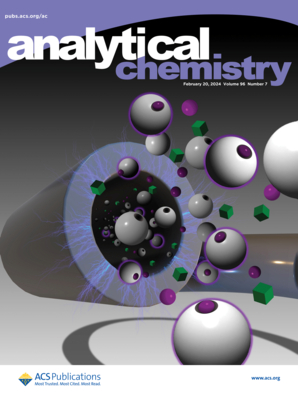Rational Design and Synthesis of Peptide-Based Probes for Fibroblast Activation Protein-Targeted Magnetic Resonance and NIR-I/II Fluorescence Imaging of Cancer-Associated Fibroblasts.
IF 6.7
1区 化学
Q1 CHEMISTRY, ANALYTICAL
引用次数: 0
Abstract
Cancer-associated fibroblasts (CAFs), characterized by the expression of fibroblast activation protein (FAP), play a pivotal role in tumor progression and therapy resistance. FAP-targeted molecular imaging offers a powerful tool for the precise visualization and quantification of CAFs within tumors. In this study, guided by molecular docking analyses, we rationally designed and synthesized two novel FAP-targeted probes, FAPtp1Mn-ICG and FAPtp2Mn-ICG, by conjugating FAP-targeted peptides, Mn-NOTA, and indocyanine green (ICG). These dual-modality probes, integrating magnetic resonance (MR) and near-infrared fluorescence (NIRF) imaging, were developed to enhance the evaluation of CAFs in gastric cancer. A key innovation lies in the introduction of a polyethylene glycol linker in FAPtp2Mn-ICG, which significantly mitigates aggregation-caused quenching (ACQ) and improves NIRF imaging efficiency compared to FAPtp1Mn-ICG. In vitro studies confirmed the high FAP-targeted specificity and biosafety of both probes. In vivo imaging in tumor-bearing mice demonstrated their excellent targeting capability and clear visualization of both subcutaneous tumors and peritoneal metastases. This work not only advances the development of FAP-targeted imaging but also provides a robust platform for the rational design of peptide-based probes for cancer diagnostics.基于肽的成纤维细胞活化蛋白靶向磁共振和nir /II荧光成像探针的合理设计和合成
以表达成纤维细胞活化蛋白(FAP)为特征的癌症相关成纤维细胞(CAFs)在肿瘤进展和治疗耐药中起着关键作用。fap靶向分子成像为肿瘤内CAFs的精确可视化和定量提供了强有力的工具。本研究在分子对接分析的指导下,通过将fap靶向肽、Mn-NOTA和吲哚菁绿(ICG)偶联,合理设计合成了FAPtp1Mn-ICG和FAPtp2Mn-ICG两种新型FAPtp1Mn-ICG探针。这些双模探针集成了磁共振(MR)和近红外荧光(NIRF)成像,用于增强胃癌中cas的评估。一个关键的创新在于在FAPtp2Mn-ICG中引入了聚乙二醇连接剂,与FAPtp1Mn-ICG相比,它显著减轻了聚集引起的淬火(ACQ),提高了NIRF成像效率。体外研究证实了这两种探针具有高的fap靶向特异性和生物安全性。荷瘤小鼠的体内成像显示了它们出色的靶向能力和对皮下肿瘤和腹膜转移瘤的清晰显示。这项工作不仅推动了fap靶向成像的发展,而且为合理设计基于肽的癌症诊断探针提供了一个强大的平台。
本文章由计算机程序翻译,如有差异,请以英文原文为准。
求助全文
约1分钟内获得全文
求助全文
来源期刊

Analytical Chemistry
化学-分析化学
CiteScore
12.10
自引率
12.20%
发文量
1949
审稿时长
1.4 months
期刊介绍:
Analytical Chemistry, a peer-reviewed research journal, focuses on disseminating new and original knowledge across all branches of analytical chemistry. Fundamental articles may explore general principles of chemical measurement science and need not directly address existing or potential analytical methodology. They can be entirely theoretical or report experimental results. Contributions may cover various phases of analytical operations, including sampling, bioanalysis, electrochemistry, mass spectrometry, microscale and nanoscale systems, environmental analysis, separations, spectroscopy, chemical reactions and selectivity, instrumentation, imaging, surface analysis, and data processing. Papers discussing known analytical methods should present a significant, original application of the method, a notable improvement, or results on an important analyte.
 求助内容:
求助内容: 应助结果提醒方式:
应助结果提醒方式:


